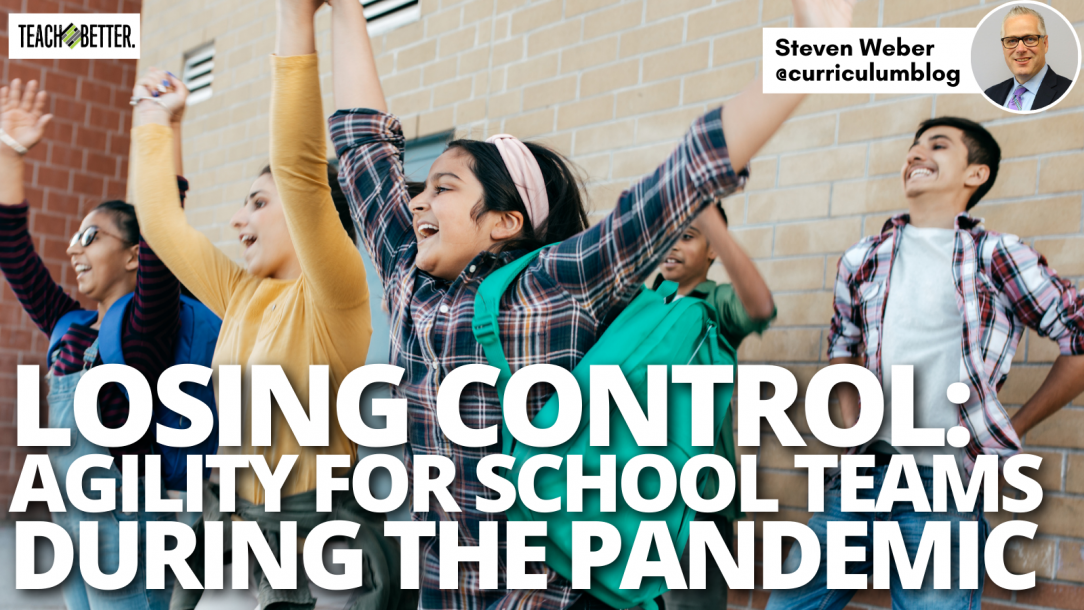TL;DR:
- Teachers and administrators have expressed a loss of control during the COVID pandemic.
- Learning agility is our ability to learn, adapt, unlearn, and relearn to keep up with constantly changing conditions.
- Clarity, scenario planning, and communication are three areas that provide agility for school teams.
Got my own mind
I want to make my own decisions
When it has to do with my life, my life
I wanna be the one in control
– Janet Jackson
Teachers and administrators have expressed a loss of control during the COVID pandemic.
The reopening of schools, open house, and teaching the first unit are a few of the traditional topics that teachers have reimagined, revised, and redesigned. When schools open, most teachers and administrators want to ‘be the one in control.’ A loss of control can create anxiety, frustration, sadness, fear, anger, or depression. Social distancing in the cafeteria may have realigned the master schedule from five lunch periods to nine. When teachers are in quarantine, it has an impact on teaching and learning. The past twelve months have taught educators to be agile, but the pandemic continues to disrupt schools.
“Learning agility is our ability to learn, adapt, unlearn, and relearn to keep up with constantly changing conditions” (Korsten, 2020). Throughout the first quarter, teachers have experienced rapid change to the opening weeks of school. Due to an increase in the number of confirmed cases of COVID and an increase in hospitalizations, some school districts made a decision to host a virtual open house.
The traditional first day of kindergarten may have meant families said goodbye to their child on the playground, rather than walking their child to class.
Several schools are not allowing families or guests to enter the school at the beginning of the school year. Several teachers have experienced students arriving for their first day of school in week three. Due to quarantine guidelines, multiple students have not been able to begin school on the first day. This has created an additional barrier for younger students who missed the opening weeks of school, classroom routines, and foundational instruction.
Teachers have navigated the constant change and uncertainty. These are not normal times and the ability to ‘control’ the future is out of our control. While we cannot control student attendance, the pace of instruction, field trips, student assemblies, and mask mandates, there are multiple ways to remain agile. Clarity, scenario planning, and communication are three areas that provide agility for school teams.
Clarity
Teacher teams can identify the next unit that will be taught. Administrators can work with school staff to determine the week’s priorities. “While you can’t predict what’s coming with perfect certainty, you can develop much more clarity than you might imagine about what you could and should become, create a plan to live into it, and then set it into motion” (Johnson & Suskewicz, 2020).
While the future may be unclear, individuals and school teams can assess the current reality and things that remain in their control. It may appear that there are multiple moving parts, yet clarity can provide school teams with confidence for the coming week.
Scenario Planning
Scenario planning provides school and district teams with more than one option. “In crisis situations such as COVID-19, scenario planning can be a useful technique to help interpret and respond to rapid change, as it allows organizations to anticipate and manage uncertainty” (Social Finance 2020).
Reflect on the past school year. Scenarios were developed for virtual learning, distribution of meals, parent-teacher conferences, teaching and learning with social distancing, and commencement. While planning for the predictable may be less time-consuming, it is not the most effective planning strategy during complexity and uncertainty. School teams must develop the skill of scenario planning in order to be prepared to meet the needs of all learners.
[scroll down to keep reading]
Communication
Teachers and administrators have learned to communicate with families via video, phone calls, newsletters, Google Classroom, email, text messages, and through social media. During a crisis, such as the global pandemic, it is important to communicate with students and families. Communication provides hope, consistency, and reassurance that there is a plan.
While the plan may not be Plan A, B, or C, families desire communication and want to know how schools are supporting their child. The uncertainty that exists in our world adds additional emotional pressure and stress to families. “We cannot have plans for all contingencies, but it is a lot easier to repurpose a plan written for another scenario than to improvise a new one” (Sibony, 2020). What does your school team need to communicate this week?
Agility for School Teams During the Pandemic: Five Questions For School Teams
- What can we control this week?
- What’s out of our control?
- What are the academic needs of our students this week?
- What are the non-academic needs of our students this week?
- How can our team be agile during uncertainty?
Conclusion
Teachers and administrators would prefer to have a roadmap for the next stage of the pandemic. However, complexity is increasing in most schools. There are more questions than answers. Educators can increase clarity by asking, ‘What is the one thing we’re going to do this week?’ An instructional strategy known as ‘chunking’ is one way teachers and administrators can survive the pandemic and the loss of control that will continue to disrupt society.
About Steven Weber
Dr. Steven Weber is the Associate Superintendent for Teaching and Learning with Fayetteville Public Schools (AR). His areas of research include curriculum design, formative assessment, professional learning, and school leadership.



